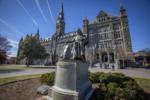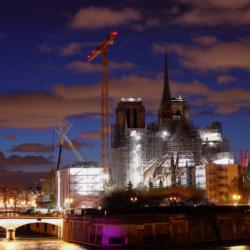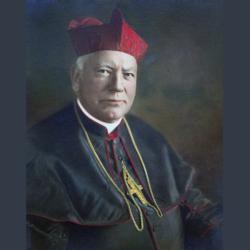Cardinal celebrates St. Patrick's Day Mass at cathedral
BOSTON -- The green-clad faithful filled the Cathedral of the Holy Cross for a St. Patrick's Day Mass celebrated by Cardinal Seán P. O'Malley in honor of the patron saint of the Archdiocese of Boston on March 17, the Fifth Sunday of Lent.
The choir, joined by a fiddler, a piper, and Irish singer Ciaran Nagle, sang hymns to St. Patrick in English and Gaelic. Students from the Irish Studies program at Catholic Memorial School in West Roxbury read the General Intercessions in Gaelic. A field of potted shamrocks was like a carpet of grass on the marble floor beside the altar, blooming beneath a wooden statue of St. Patrick flanked by bouquets of white lilies, candelabras, and the Irish flag. The shamrocks were blessed during the Mass and distributed by the Catholic Memorial students after the final blessing.
In his homily, the cardinal recounted the story of St. Patrick's life and ministry. Contrary to popular belief, he said, St. Patrick was not Irish by birth. He was born to a middle-class Roman family in Britain, then a territory of the Roman Empire. He lived a wayward teenage existence before he was kidnapped by pirates and sold into slavery in Ireland. Like Sts. Francis and Ignatius of Loyola, St. Patrick experienced conversion while suffering in captivity.
"Had he not been kidnapped," Cardinal O'Malley said, "he probably would have married some fetching British damsel, landed a mid-level job in the provincial government, and died in obscurity, doting on his grandchildren, and no one would ever know that Patrick existed."
Instead, the cardinal said, St. Patrick used his experience to strengthen himself and, in doing so, "change the course of history."
In his "Confessions," St. Patrick described himself as "a sinner, the most unlearned of men, the lowliest of all the faithful, and utterly worthless in the eyes of men." Cardinal O'Malley thinks it would be more accurate to describe the young St. Patrick as leading a "self-centered, superficial existence steeped in mediocrity."
"Fear of the cross is what so often makes us mediocre," the cardinal continued. "Patrick was cured of his mediocrity by the great suffering he endured as a slave."
After six years in slavery, St. Patrick escaped and stowed away on a ship carrying dogs to Britain. After greeting his ecstatic family, who had no way of knowing whether he was still alive, he returned to Ireland to serve as a missionary. He never saw his family again. During his enslavement, St. Patrick had learned the Irish language and culture, and loved it. Cardinal O'Malley called him "an Irish wannabe."
According to tradition, when St. Patrick's enslaver heard that he was coming back to Ireland, he killed himself. He never could have imagined that, rather than get violent revenge, St. Patrick wanted to bring the love and charity of the Gospel to his tormentors.
"I am convinced that the most powerful aspect of Patrick's spirituality was his capacity to forgive, to actually love his enemies," the cardinal said. "We Irish know how difficult that can be."
"He was on fire with a sense of vision to carry Christ to those who did not know him and yet were longing for meaning in their lives," Cardinal O'Malley said.
After bringing Christianity to Ireland, centuries of Irish missionaries followed in St. Patrick's footsteps. Thanks to them, St. Patrick is beloved far beyond Ireland, the cardinal said.
Many Catholic churches in Nigeria are named after him. In Puerto Rico, one of the oldest churches on the island is named after St. Patrick. It is located in the town of Loiza, where much of the population is descended from enslaved Africans. Inside the church, there is a statue depicting St. Patrick as a Black man. On the Caribbean island of Montserrat, historically home to many enslaved Africans and Irish indentured servants, St. Patrick's Day commemorates an 18th-century slave rebellion. The island's flag depicts Erin, the personification of Ireland, holding a Celtic harp and a cross.
"I think Patrick would be so pleased by his association with emancipation," Cardinal O'Malley said, "because Patrick's one purpose in life was to bring the liberating power of Christ's Gospel to people."
And, the cardinal said, Catholicism spread in the U.S. thanks in part to Irish immigrants, who built many churches named after their homeland's patron saint. One year after the start of the Great Famine, one-third of Boston's population was Irish Catholic.
"It must have seemed like an invasion," Cardinal O'Malley said. "Not surprisingly, not everybody was glad to see us."
He noted that the Cathedral of the Holy Cross was built by first-generation Irish immigrants, who managed to raise funds for its construction while sending money to their starving families back in Ireland.
"The history of the Irish people is filled with tragedy and suffering," he said, "but the treasure of the faith that we received from Patrick has given us the strength not just to endure, but flourish."
He said that those who are spiritually descended from St. Patrick must follow his example of mercy and charity.
"I hope no Irish person will be indifferent when we hear of hunger in our community," he said, "and famine in our world . . . I pray that our Catholic faith and history will teach us how to be compassionate to those who are hungry, those who are homeless, those who are refugees fleeing starvation and oppression. Like Patrick, may we learn how to forgive, how to turn enemies into friends in a divided world."
After Mass, there was a reception below the sanctuary with Irish soda bread, shamrock-shaped cookies, and lively music played on the accordion and guitar.


















